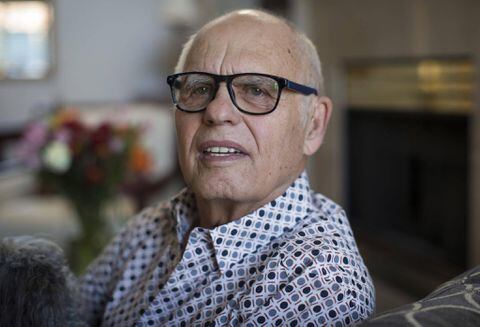B.C. doctor says Canadian-led heart valve surgery will ‘blow people’s minds’
Max
Morton, 81, sits for a photograph at his home in Richmond, B.C., on
Monday Oct. 30, 2017. Morton is one of 411 patients who had
transcatheter aortic valve replacement surgery where the damaged aortic
valve is replaced without removing the old one. The procedure is an
alternative to the more invasive open-heart surgery.
DARRYL DYCK/THE CANADIAN PRESS
A
Vancouver cardiologist has presented details of a revolutionary heart
valve surgery to thousands of doctors from around the world and says the
minimally invasive procedure will "blow people's minds."
Dr.
David Wood led a study involving 411 patients who underwent an
operation called 3M transcatheter aortic valve replacement for treating
aortic heart valve disease, at 13 centres across North America, 11 of
them in Canada.
"It's going to
change, we think, not just North American, but global practice," Wood
said Monday before presenting the study at the annual Transcatheter
Cardiovascular Therapeutics conference in Denver, where 15,000 attendees
had enrolled.
Instead
of invasive open heart surgery, which requires general anesthetic,
slicing of the sternum, or breastbone, and long hospital stays and
recovery time, patients were awake for the 45-minute procedure and
walking within a few hours. Eighty per of them went home the next day.
"You
had no breathing tube, no catheter in your bladder, you could return to
work the next day, you could be driving the next day. These are things
that I think the average person can't believe are feasible in 2017,"
said Wood, who practises at Vancouver General Hospital and St. Paul's
Hospital in the same city.
The
aortic valve is the most important of four heart valves and leads from
the heart to the body, supplying blood to the head, lungs and muscles.
It wears out and narrows with age.
The median age of patients in the study was 84, and their symptoms include chest pain and shortness of breath.
"Once
you start getting symptoms, 50 per cent of people are going to be dead
within a year so it's absolutely imperative that you fix that valve,"
Wood said.
The new innovation builds
on a technique pioneered by Wood's colleague Dr. John Webb in 2005,
which still required general anesthetic and a week-long hospital stay.
"By
doing less, actually the patients did better," he said of their work
done at the Centre for Heart Valve Innovation involving St. Paul's, VGH
and the University of British Columbia.
"It's
truly been a revolution," he said, adding the latest procedure means
quality of life for patients and cost savings for the health-care
system, aspects his team are looking into quantifying.
Sister
Theresa Stickley had the "miracle" surgery in 2013 at age 83 when she
lived in Squamish, B.C., and became increasingly exhausted and had
difficulty breathing.
"The doctor
told me I was very close to death and had a couple of months only to
live," Stickley said of the surgery that meant she didn't have to have
her "whole chest bone sawed through."
"I
was walking right after the surgery," she said from the Monastery of
the Angels in Los Angeles, where the American-Canadian citizen moved
last year.
Max Morton, 79, was the
first person to have the procedure as an emergency-room patient at
Vancouver General Hospital. He'd already had open heart surgery a decade
earlier.
"Within 24 hours I
thought, well, this is nice. It was such an amazing experience being
awake for the whole thing," he said from his home in Richmond, B.C.,
adding he went fishing five days later.
"The
only reason Max is alive is because we'd been doing the study and we
were able to use that technique for Max. That's why he's such an amazing
story. No one had ever done it before like that."
Video: Girl’s brain tumour treatment aided by genetic-based test (The Canadian Press)

No comments:
Post a Comment